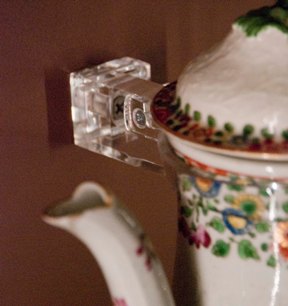Protecting Art in an Earthquake
When a natural disaster strikes, like the recent earthquake in China1, saving human lives is naturally the first concern. In the aftermath however, the loss of cultural artifacts and historic sites can be devastating to communities as well. Art and architecture provide evidence of our shared histories and give us a foundation on which to build a common identity. Living in Seattle, an area of the world prone to seismic activity, one might ask what Fremont would be like without its troll, or the Seattle skyline without the Space Needle? Hopefully, we will never know.
Part of SAM’s mission is to preserve art for future generations. Seismic mitigation, to protect the art while it is on view, is the job of SAM’s mountmakers. When designing object mounts, mountmakers assume three things: there is a floor, a ceiling, and walls. If those are gone, the best mount in the world won’t provide protection. However, even a minor earthquake can cause irreparable damage to an object by shaking it or knocking it over. SAM’s mountmakers use a variety of techniques to keep the art safe while minimizing visual distraction for the viewer. Here are some of them.
Small pieces, such as the lamp shown here, are fitted with Plexiglas contour mounts. Each mount is uniquely shaped to fit the object it will protect. The transparency and narrow profile of the mount make it almost invisible to the viewer from most angles.
Rebecca Raven works on an 18th century Meissen vase. Vase, 1730 – 35, hard paste porcelain with enamel colors, luster and gilding, German, Meissen, 9 5/8 in. Diam.: 2 1/2 in. Girth: 16 1/4 in., Gift of Martha and Henry Isaacson, 69.205. Photo: Natasha Lewandrowski
SAM mountmaker Rebecca Raven carefully attaches a vase to a contour mount using a piece of monofiliment. The mount is screwed into base from below.
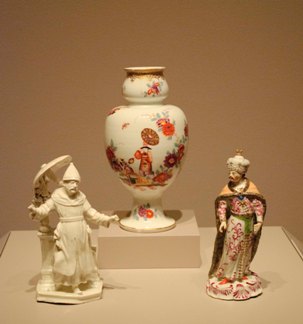
Objects left to right: Figure, ca. 1760s, soft paste porcelain, Spanish, Buen Retiro, 8 x 4 5/8 x 3 1/4 in., Dorothy Condon Falknor Collection of European Ceramics, 87.142.75; Vase, 1730 – 35, hard paste porcelain with enamel colors, luster and gilding, German, Meissen, 9 5/8 in. Diam.: 2 1/2 in. Girth: 16 1/4 in., Gift of Martha and Henry Isaacson, 69.205; Figure, ca. 1775, hard paste porcelain with enamel colors and gilding, German, Limbach, model by Caspar Jensel, 7 7/8 x 3 in., Gift of Martha and Henry Isaacson, 76.126. Photo: Natasha Lewandrowski
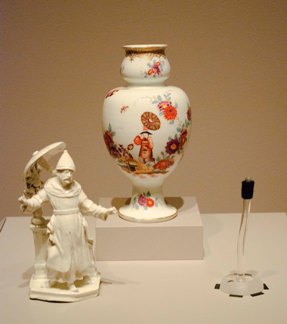
Photo: Natasha Lewandrowski
Hollow objects, such as the figure on the right in this case, may be held in place internally. The Plexiglas rod is perfectly fitted to the object, supporting it from within.
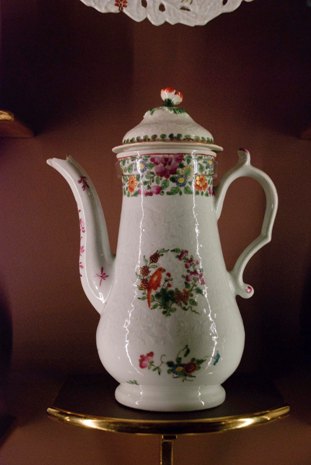
Coffeepot, ca. 1768, soft paste porcelain, English, Worcester, 9 1/4 x 7 in., Gift of Martha and Henry Isaacson, 76.174. Photo: Natasha Lewandrowski
Half the objects currently on view at SAM are in the Porcelain Room. Each one is fitted with a unique mount. To hide the visibility of the mounts, SAMs mountmakers took into account not only the shape of the object, but the angle from which viewers would see it.
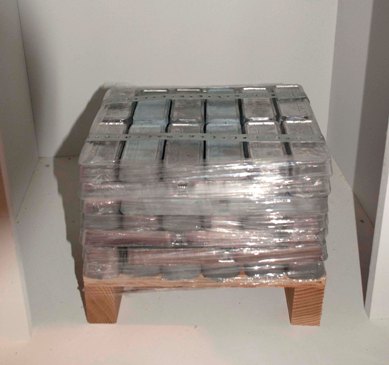
Photo: Natasha Lewandrowski
One of the simplest ways to protect an object in a case is to lower its center of gravity by adding weight to the base.
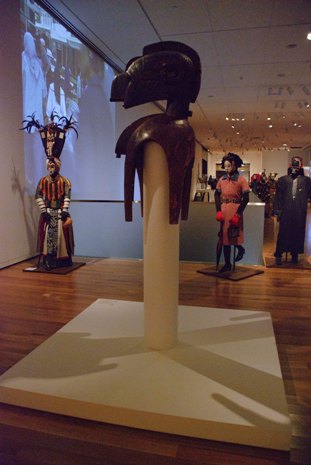
Platforms help stabilize tall pieces by distributing their weight over a large area.
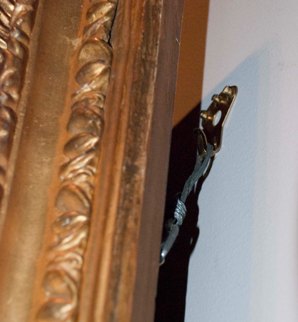
Photo: Natasha Lewandrowski
Art that hangs on walls can be leashed to load bearing contact points. If the wall started to shake the painting would swing rather than fall. No mount is disaster proof, but these details might mean the difference between an object getting nudged a little out of place or being completely destroyed if an earthquake hit Seattle.
Natasha Lewandrowski, Museum Services and Curatorial Coordinator
1This post was written before the earthquake in China’s Qinghai province on April 14. Our thoughts are with the people of that region. If you are interested in donating to the relief efforts, visit http://www.redcross.org/.
Top photo: Mosque lamp, first half 14th century, glass, Syrian, 11 3/4 in. Girth: 26 in. Diam.: 6 5/8 in. Eugene Fuller Memorial Collection, 54.37. Photo: Natasha Lewandrowski
